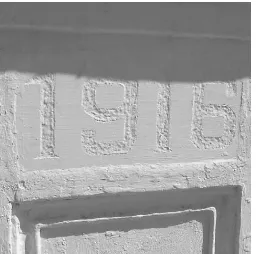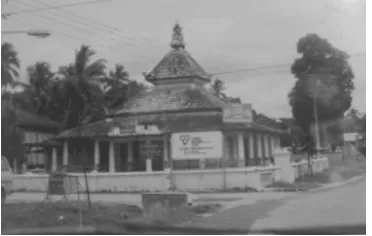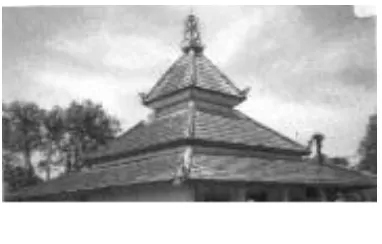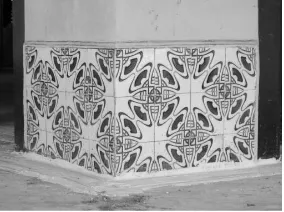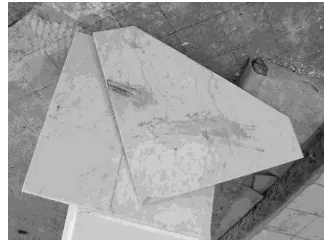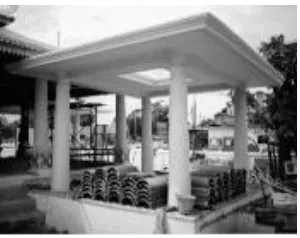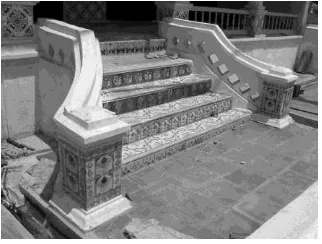Journal of Islamic Architecture Volume 1 Issue 3 June 2011 | 151
MOSQUE WITHOUT DOME: CONSERVING TRADITIONAL-DESIGNED
MOSQUE IN MELAKA, MALAYSIA
Roslan B. Thalib School of Housing, Building, and Planning
University Sains Malaysia
11800 USM Pulau Pinang Malaysia e-mail: roslantalib@usm.my
M. Zailan Sulieman School of Housing, Building, and Planning
University Sains Malaysia
11800 USM Pulau Pinang Malaysia
Abstract
Jasin is one of the area in the state of Malacca in Malaysia, known for its long winding history. Located in the middle seat of government of the Empire of the famous Melaka Sultanate, Jasin district does have a number of quality historic buildings. One of the old buildings found in one the villages located quite close to the town of Jasin is the unique domeless Air Barok Village Mosque. Its location is situated along the main road, easy to reach. In a study stated in this paper, it shows how the unique architecture of this mosque of Air Baroque Village can be appreciated. This paper presents a study of the design elements and architectural features that are unique to the mosque around this region. This paper stated on the approach in creating this structure is different compared to most of the existing mosque currently and previously being built around the state. The concept of neo-archipelago idea to have the Chinese Buddha features in a Muslim mosque was unique found on this religious building located at the side of the world. Expectations for this study to reveal the noble efforts of the Government bodies involved in restoring old buildings such as this mosque can indirectly maintain the cultural arts of the local Malays who are the largest race in Malaysia. Efforts should also be given to maintain old buildings; not only religious buildings but also other building types; in the effort to ensure local arts and culture still exist and can be appreciated by future generations.
Keywords: Traditional mosque, conservation, mosque history, Melaka mosque
Abstrak
Jasin merupakan salah satu daerah di negara bagian Melaka di Malaysia yang dikenal karena sejarahnya yang panjang berliku. Terletak tepat di pusat kedudukan pemerintahan Kesultanan Melaka yang terkenal, daerah Jasin memang memiliki sejumlah bangunan bersejarah kualitas. Salah satu bangunan tua yang ditemukan di salah satu desa yang terletak cukup dekat dengan kota Jasin adalah sebuah masjid unik tanpa kubah, yaitu Masjid Desa Air Barok. Lokasinya terletak di sepanjang jalan utama sehingga mudah dijangkau. Dalam sebuah studi dipaparkan apresiasi tentang keunikan arsitektur dari Masjid Desa Air Barok. Tulisan ini menyajikan studi tentang unsur-unsur desain dan fitur arsitektur yang unik bagi masjid di sekitar wilayah ini. Tulisan ini menyatakan pendekatan dalam menciptakan struktur ini berbeda dibandingkan dengan sebagian besar masjid yang ada saat ini dan yang sebelumnya sudah dibangun dibangun di negara itu. Konsep ide neo-archipelago yang memiliki fitur-fitur Buddha - Cina pada masjid Muslim merupakan sesuatu yang unik ditemukan di bangunan religius. Harapan untuk penelitian ini untuk mengungkapkan upaya mulia dari badan pemerintah yang terlibat dalam memulihkan bangunan tua seperti masjid ini yang secara tidak langsung dapat mempertahankan seni budaya lokal Melayu sebagai ras terbesar di Malaysia. Upaya-upaya lainnya juga harus diperjuangkan untuk mempertahankan bangunan tua, tidak hanya bangunan agama, tetapi juga jenis bangunan lain, dalam usaha untuk memastikan seni dan budaya lokal tetap eksis dan dapat dihargai oleh generasi mendatang.
Kata kunci: Sejarah masjid, masjid Melaka, masjid tradisional, konservasi
Introduction: History and Background of Air Barok Village
Air Barok Village is located in the Jasin district. It is located between the Kesang Village and Jasin Town. Map (Figure 5) shows the location of the village on the map. Majority of the population is made up of Malays and some
|
Journal of Islamic Architecture Volume 1 Issue 3 June 2011 | 153
culture. In addition, the river is also very important as a means of transportation to get to other destina- tions.
When their forefathers found the river, there is a group of apes bathing in the river. This resulted in their bath water is called Air Beruk (‘beruk’in Malay language means apes) and the name of this that the village has been pioneered by Datuk Senara who are also act as Jasin Town chieftain. However, this theory has no clear evidence to determine the authenticity. Perhaps this is the conclusion of the old residents of this village is said to be confused with Datuk Senara's grave in the town of Jasin, located close to the village. It is possible that if this statement is true; Datuk Senara can be the most important person in the development of the Air Barok Village and also the development of Jasin Town.
The Original Proposals of Air Barok Village Mosque
From the observation of several interviews with the villagers, the mosque was built in 1916. 1916 is stated at the gate’s wall of this mosque (Figure 1) further strengthen this statement. However, in an interview made with Haji Ahmad Yunus, who was born in 1917 and Haji Saadon Haji Yahaya, who was born in 1936; the date stating the existence of this mosque is much earlier because the fence were built many years before the mosque main building has been built (maybe between 1914).
Figure 1. Date (1916) written on the walls of the Air Baruk Mosque gates
However, this statement cannot be confirmed because there is no concrete evidence of this fact. From this interview, it is known that the mosque was
built by wealthy people who donated the site where the mosque was built, namely Haji Babu (Figure 2). He is known as a rich urban folks and well-known to the nearby villages such as the village of Chin Chin where he lived, and Air Barok Village and also Rim Village (Figure 3).
wealthy people who lived near the area. From to be purchased for the construction of the mosque. According to the villagers again, the construction of belian pillars (belian is the type of local timber) is in addition to supporting the roof; is donated from unidentified wealthy person. Namely, each belian columns have their own donors who supported the construction of those belian pillars.
Figure 4. Air Barok Village Mosque was found by the Department of Museum Antiquities that is not used
anymore in 1989 surrounding villages before the construction of other mosques. In addition to re- ligious activities, the mosque is also used for Friday prayers congregation by local residents. Activities of Air Barok Village Mosque was active until the main Jasin Jamek Mosque was constructed and completed located nearby; within the city of Jasin. This is because the expand of local population resulting in demand for more praying space.
Therefore, the mosque is no longer used for congregational prayers but only used for regular prayer time only. But still, there are classes to study the Quran at the mosque. However, after islamic school building beside it was built, the mosque is not used anymore. This is according to Mr. Isnordin from the Department of Antiquities told that the mosque is not in use yet when they make a visit in 1989 (Figure 4) to lead the proposed conservation work that has been done in early 2000.
Site of Air Barok Village Mosque, Maintenance Rights, and Construction Development
Air Barok Village Mosque is located on the outskirts of the road to the Kesang-Jasin Town trunk road. There is a restaurant located in front of the mosque and a religious school is located on the left, and the back is made up of residential houses; the land site location of this mosque to the public.
Figure 5. The location plan Air Barok Village Mosque, shown in dark square (Source: City Council of Jasin)
The mosque was guarded and managed by the
Journal of Islamic Architecture Volume 1 Issue 3 June 2011 | 155 Figure 6. Masjid Kampung Air Baroque, as it is now
There is a major component in the construction of a mosque as described in this analysis report which is the main components of the mosque. Analysis made on this mosque is based on a heritage survey provided as guidance by Badan Warisan Malaysia (Malaysia Heritage Board). From the analy- sis made, Air Barok Village Mosque has heritage features and the architecture of the mosque cons- tructed within the Nusantara Archipelago vocabu- lary. The building was undergoing conservation work and retention of original design by the Department of Museums and Antiquities (see Figure 6). In terms of suitability to the climate, the roof rise and there is some kind of louvers around the façade to facili- tate the process of building ventilation. The orienta- tion before the Qiblah (in Mecca, Saudi Arabia) which is a common principle used in the construction of each of the mosques. Hopefully, further metric study of this Air Barok Village Mosque will be made and described in the next section study.
Building Context
The mass of the mosque is shaped in such a way having a tiered roof. It is an example of the main elements of the architecture of building of a mosques in Melaka. A view of certain corner of the mosque are shows on this picture below (Figure 7 -
9).
Figure 7. Angular view of Air Barok Village Mosque
Figure 8. View towards the upper part of Air Barok Village Mosque
Figure 9. The Verandah; side view of Air Barok Village Mosque
Plan
In plan, the mosque shape is square and is surrounded by a porch on each 'façade' except the 'façade' facing the Qaaba direction that is adjusted to the roof. There are certain principles to plan the shape of this square as in relation to the design philosophy on Traditional Malay archipelago Mosque. Air Barok Village Mosque building is the size of approximately 20 meter wide and long.
Building Modules
Building module is comprised of five parcels (five bay) and not linked to any other building. The verandah (anjung) is the first and last compartment and the second through fourth compartment is the prayer hall. If look in plan mode, the building have a strip of buildings that made-up the mosque building module. The mosque height is one and a half higher of the typical building height.
Basis of Buildings
Wall
Building material for wall base (foundation wall
Outside the Open Verandah
There is an open verandah area at the mosque material) and the wall of the raw material used
is concrete bricks in the outer plaster. In addition, the wall which is also decorated with a tile pattern (Figure 10). Tile material is originated from Italy and have certain privileges.
Figure 10. Finishes the beautiful tiles on the bottom of the concrete wall
around the sides and front facade. It is surrounded by 'balustrade' of concrete and several columns as described above (Figure 13). There are also front yard installed with terracotta flooring at the outside of the building.
Figure 13. Mosque of Air Barok’s porch
Pillar
There are two types of columns/pillars in the mosque. The four pillars of the belian type (the term
Roof
This is the type of roof mosque called roof for the pillars supporting the roof of every mosque in
Archipelago/Nusantara region) (Figure 11) on the inside of the mosque is decorated with a concrete pillar with tile pattern on its whole surface. For columns on the porch located outside; also having decorative feature at the bottom of the concrete pillar (Figure 12).
Figure 11. The belian pillar pole tidy-up with colorful floral motive tiles designed as a whole
Figure 12. On the porch column
Meru. In terms of suitability to the climate, the roof rise should facilitate the process of ventilation. But the function of roof ventilation components to suit the installation does not work because there is a ceiling on the mosque. Roof design is based on the architectural design of mosques in the Archipelago that uses elements of the tiered roof ventilation agent. Due to the lack of understanding; the function of this multilevel roof design used in this mosque shows the image without emphasizing the function of design. Finishes on the roof is from pieces of roof tiles called ‘marsile’ made from clay (Figure 14). The fascia board of the building made of the board with engraved pattern.
Journal of Islamic Architecture Volume 1 Issue 3 June 2011 | 157
Crown
Crown (instead of dome) is the most special item for each Traditional Melaka/Malacca Mosque. Like other mosques of Malacca which is consisted of three levels of the ridge, the crown is one of the arts of the Malays who poured into the sacred building. Each level represents a certain level. Air Barok Village Mosque crown is made of concrete materials. If you see this section in the mosque of Air Barok there is Buddhist influence in its design. The pattern form resemblance of the modified abstracted dragon image (Figure 15).
Figure 15. The Crown Air Barok Village Mosque
Ridge/‘Salur Bayung’
The ‘Salur Bayung’ of Air Barok Village Mosque is in the same
shape
with other traditional mosques in Melaka. Its ‘Salur Bayung’ is made of concrete. The ‘Salur Bayung’feature is inspired from the stem were taken from a wild plant in the water. It also reflects the first time of ‘tahhiyat’ in the prayer. If carefully viewed; in this ‘bayung’ stem; one can noted that the image of a pagoda in the design of this mosque. This view enhanced the fact that design elements of the mosque have influenced of the Buddha in it (Figure 16).Figure 16. Stem/’Salur Bayung’at Air Barok Village Mosque
Windows and Doors
Windows are shaped with non-decorative elements and its finishes leaving flat surface (Figure
17). Similarly, the door of the mosque is in the form of an empty flat and finish with flat board.
Figure 17. The detail of the window
Floor
Floor finishes are of a large marble tiles. It was
bought from
Italy
as explained earlier (Figure 18 and 19).Figure 18. Original marble tiles as floor finishes being removed
Figure 19. New marble tiles used as floor finishes
Chamber/Mihrab
Figure 20. The views of the mosque sanctuary
Well
Figure 23. The pits at the mosque
These wells are used for ablution before the
Figure 21. External view of the sanctuary of the mosque
Pulpit/Mimbar
For the pulpit, the
mosque
has decorated ceiling decorated with interesting sculptures become an important component of the mosque and became a preacher sermon during the weekly Friday Prayer (Figure 22).Figure 22. Air Barok Village Mosque pulpit
Pits/’Kolah’
Not the original structure of the mosque. Built to enable more pilgrims to perform ablution before prayer been made together, especially the Friday prayers. Materials consist of concrete construction with ceramic tiles (Figure 23).
pits been build or after the wells has been constructed, the pits are no longer in use. Well construction materials that are cylindrical brick plaster is unique to show the beauty of the bricks used as construction materials (Figures 24, 25).
Figure 24. Water wells of the Air Barok Village Mosque
Figure 25. Construction materials used as well finish
Main Door/Gate
Journal of Islamic Architecture Volume 1 Issue 3 June 2011 | 159
Stairs
Figure 26. The main entrance of mosque
Preliminary Conclusion
Conclusions from this analysis, found that the mosque has a distinctive architectural beauty pre- served by the conservation projects undertaken by the Department of Museums and Antiquities. Conservation project will allow the architecture of Air Barok Village Mosque is appreciated on its retention of original form.
With typical mosques around the world to make the dome as the main element, the Mosque of Air Barok Village is a unique show with no dome. Its design is more akin to the influence of Chinese Buddhism. The oriental influences on its architectu- ral design show the kind of traditional Malay mosque
Like the concept of traditional Malay houses are commonly found in Melaka, treated as the aesthetic elements to invite guests in its design. Similarly with this mosque, this types of the concrete stairs is having very exciting finish tiles seem to invite people in the mosque. At the main entrance, the stairs (Figure 27) seems longer compared to the side entrance and the main entrance’s stairs having special features and design finishes. This is possible because there are strong elements of the main gate entrance to show-off. In contrast to the more hidden stairs located on side entrance, the design steps (Figure 28) is less interesting in term of its design finishes tiles.
Figure 27. The stairs at the main gate
Figure 28. Stairs at the entrance of the mosque side
which still can be found around this particular region. This mosque must be retained to its original form as to highlight the uniqueness of the vernacular mosque architecture for future generations to admire.
References
1 M. Brett and W. Forman. 1980. The Moors: Islam in the West. London: Orbis Publishing. 2 Voon F. Chen. 1998. The Encyclopedia of
Malaysia. Archipelago Press.
3 P. Davies. 1987. Splendours of the Raj: British Architecture in India 1660-1947. Middlesex: Penguin Books.
4 Mohd. Tajuddin Mohd. Rasdi. 2001. Identiti Senibina Malaysia. Penerbit UTM.
5 A.H Nasir. 1984. Mosques of Peninsular Malaysia. Kuala Lumpur: Berita Publishing Sdn. Bhd.
6 A.H Nasir. 1987. Traditional Malay Wood Carving. Kuala Lumpur: Dewan Bahasa dan Pustaka.
7 K. Yeang. 1992. The Architecture of Malaysia.
